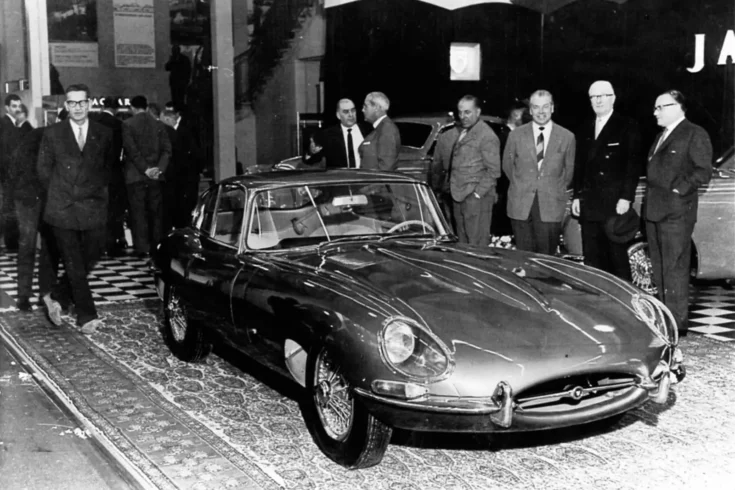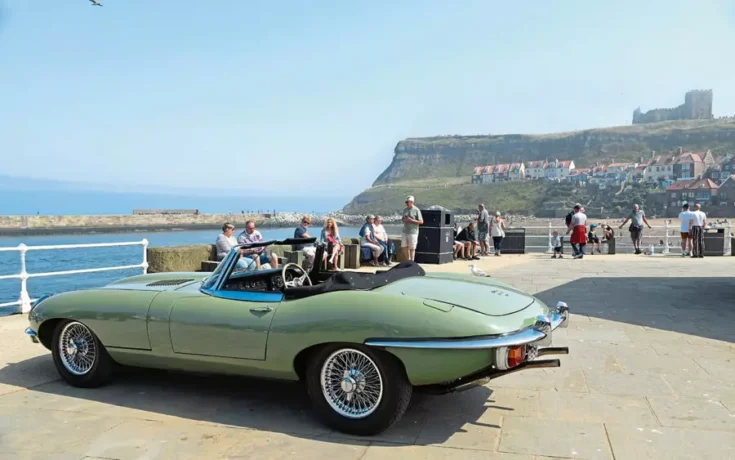Step back in time and prepare to be captivated by the timeless beauty of the Jaguar E-Type. A true icon of automotive design, this legendary British sports car continues to turn heads and evoke a sense of awe even today. From its sleek and aerodynamic body to its powerful engine, the E-Type was a game-changer in the industry when it was first introduced in 1961.
With its long hood, curvaceous lines, and distinctive headlights, it exuded an undeniable sense of elegance and sophistication. But it wasn’t just its stunning looks that made the E-Type a legend. Underneath its stunning exterior, it boasted impressive performance and handling that set it apart from its competitors. Join us as we take a nostalgic journey through the history of the Jaguar E-Type, exploring its enduring legacy and the impact it has had on the world of automotive design.
Historical significance of the Jaguar E-Type

Source: pinterest.com
The Jaguar E-Type holds a special place in automotive history, as it marked a turning point in the industry. When it was unveiled at the Geneva Motor Show in 1961, it caused a sensation among car enthusiasts and the general public alike. Its sleek and futuristic design was unlike anything seen before, and it signaled a new era of automotive design. The E-Type quickly gained a reputation as one of the most beautiful cars ever made, with its long, sweeping lines and perfectly proportioned body. It was an instant classic, capturing the hearts of car enthusiasts around the world.
The impact of the E-Type extended beyond its stunning looks. It was also a technological marvel, featuring advanced engineering and innovative design elements. Under the hood, it housed a powerful inline-six engine that delivered impressive performance. With a top speed of 150 mph and a 0-60 mph time of just 6.9 seconds, the E-Type was one of the fastest cars of its time. Its independent suspension and disc brakes further enhanced its handling and driving experience. The E-Type was a true sports car that combined beauty and performance in a way that was unmatched by its competitors.
The E-Type’s historical significance is further highlighted by its influence on other automakers. Its design elements, such as the long hood and curvaceous lines, inspired a generation of sports cars that followed. The E-Type set the benchmark for automotive design, and its impact can still be seen in modern-day sports cars. Its timeless beauty and groundbreaking engineering continue to inspire car enthusiasts and designers alike.
Design and engineering of the Jaguar E-Type
The design of the Jaguar E-Type is a masterpiece of automotive art. Its long, sleek body is the epitome of elegance and sophistication. The flowing lines and smooth curves give it a sense of motion, even when it’s standing still. The E-Type’s design was heavily influenced by aerodynamics, with its low drag coefficient and streamlined shape. Every aspect of its design was carefully crafted to maximize performance and efficiency.
The E-Type’s design was not just about aesthetics; it also had a functional purpose. The long hood was necessary to accommodate the powerful inline-six engine, while the low-slung stance and wide track improved stability and handling. The distinctive headlights, with their glass covers, added to the car’s unique and unmistakable appearance. Even the interior of the E-Type was designed with the driver in mind, with its ergonomic layout and comfortable seating position.
In terms of engineering, the E-Type was ahead of its time. It featured a monocoque construction, which made it lightweight and rigid. This, combined with its advanced suspension and disc brakes, gave the E-Type exceptional handling and stopping power. The car’s performance was further enhanced by its powerful engine, which was derived from Jaguar’s racing heritage. The E-Type was truly a marvel of engineering, combining beauty and performance in a way that was unprecedented.
Performance and driving experience of the Jaguar E-Type

Source: pinterest.com
Driving an E-Type is an experience like no other. The combination of its stunning design and exhilarating performance creates a sense of excitement and joy that is hard to match. As soon as you step on the accelerator, you can feel the power of the engine propelling you forward. The E-Type’s inline-six engine delivers smooth and effortless acceleration, with a throaty exhaust note that adds to the overall driving experience.
The E-Type’s handling is equally impressive. Its precise steering and balanced chassis make it a joy to drive on twisty roads. The car feels planted and composed, even at high speeds. The independent suspension soaks up bumps and imperfections in the road, ensuring a comfortable and controlled ride. The disc brakes provide excellent stopping power, giving the driver confidence and peace of mind.
One of the most remarkable aspects of the E-Type’s performance is its versatility. It’s just as comfortable cruising on the highway as it is carving through corners on a race track. Whether you’re taking a leisurely drive or pushing the car to its limits, the E-Type never fails to deliver an exhilarating and engaging driving experience.
Notable models and variations of the Jaguar E-Type
Over the years, several notable models and variations of the Jaguar E-Type were introduced, each with its own unique characteristics and features. One of the most iconic variations is the E-Type Series 1, which was produced from 1961 to 1968. This is the model that captured the hearts of car enthusiasts around the world with its stunning design and exceptional performance. The Series 1 is often considered the purest and most desirable version of the E-Type.
Another notable variation is the E-Type Series 2, which was introduced in 1968. This version featured several design changes, including a larger grille and repositioned headlights. The Series 2 also introduced a more comfortable interior and improved cooling system. While some purists prefer the original Series 1, the Series 2 is still highly regarded for its refined design and enhanced usability.
In 1971, the E-Type Series 3 was introduced, featuring a larger V12 engine and a more luxurious interior. The Series 3 was designed to cater to the American market, with its increased power and comfort. While the Series 3 is often criticized for its weight and reduced agility compared to the earlier models, it still retains the timeless beauty and performance that made the E-Type a legend.
Jaguar E-Type in pop culture and media

Source: youtube.com
The Jaguar E-Type’s timeless design and legendary status have made it a favorite among filmmakers, artists, and car enthusiasts in popular culture. Its appearance in movies and TV shows has only added to its iconic status. One of the most famous appearances of the E-Type is in the 1963 film “The Italian Job,” where a red E-Type is driven by the main character, played by Michael Caine. The car’s sleek and stylish appearance perfectly complemented the glamorous and thrilling nature of the film.
The E-Type has also been featured in numerous music videos, album covers, and works of art. Its striking design and undeniable presence make it a favorite subject for photographers and artists. The E-Type’s timeless beauty continues to inspire and captivate people from all walks of life.
Collectibility and value of the Jaguar E-Type
The Jaguar E-Type is not only a masterpiece of automotive design but also a highly sought-after collectible car. Its rarity, timeless beauty, and historical significance have contributed to its value and desirability among car collectors. Well-preserved examples of the E-Type can command high prices in the collector car market.
The value of an E-Type depends on several factors, including its condition, originality, and rarity. Early Series 1 models, especially those with desirable features such as covered headlights and flat floors, are typically more valuable. Limited-edition models, such as the Lightweight E-Type, are highly sought after by collectors due to their exclusivity. The E-Type’s value has been steadily increasing over the years, making it a sound investment for car enthusiasts and collectors.
Restoring and maintaining a Jaguar E-Type
Restoring and maintaining a Jaguar E-Type requires a meticulous approach and attention to detail. Due to the car’s age and complexity, it’s important to find a qualified and experienced Jaguar specialist for any restoration or maintenance work. These professionals have the knowledge and expertise to ensure that the E-Type is restored to its original condition and that it continues to perform at its best.
Restoration of an E-Type typically involves a thorough inspection of the car’s body, engine, and interior. Any rust or damage must be carefully repaired, and original components should be sourced whenever possible. It’s important to maintain the authenticity of the E-Type during the restoration process, as this enhances its value and historical significance.
Regular maintenance is also crucial for keeping an E-Type in top condition. This includes routine checks and servicing of the engine, suspension, brakes, and electrical systems. The E-Type’s owner should also be diligent in preserving the car’s appearance, such as keeping the paintwork clean and polished. By following a proper maintenance schedule and taking care of the car, an E-Type can provide years of enjoyment and continue to be a prized possession.
Modern-day successors and influence of the Jaguar E-Type

Source: youtube.com
The Jaguar E-Type’s influence can be seen in many modern-day sports cars, as automakers continue to draw inspiration from its timeless design and engineering. The long hood, curvaceous lines, and aerodynamic shape have become iconic design elements that are often replicated in contemporary sports car models. The E-Type’s legacy lives on through these successors, which pay homage to the original while incorporating modern technologies and advancements.
Jaguar itself has paid tribute to the E-Type with the introduction of the F-Type, a modern-day sports car that captures the spirit and essence of its predecessor. The F-Type features a design that echoes the E-Type’s classic proportions and curves, combined with cutting-edge technologies and performance. It is a worthy successor to the E-Type, carrying on its legacy of beauty and performance.
The E-Type’s influence extends beyond the automotive industry. Its timeless design has inspired other forms of art and design, from architecture to fashion. The E-Type’s status as a design icon continues to resonate with people, reminding us of the power of great design to captivate and inspire.
Conclusion: The enduring legacy of the Jaguar E-Type
The Jaguar E-Type is a true legend in the world of automotive design and performance. Its timeless beauty, exceptional engineering, and groundbreaking design continue to captivate car enthusiasts and casual observers alike. From its debut in 1961 to its influence on modern-day sports cars, the E-Type has left an indelible mark on the world of automotive design.
The E-Type’s enduring legacy is a testament to its enduring appeal and significance. It represents a bygone era of automotive excellence and craftsmanship, where beauty and performance were intricately intertwined. Whether admired for its stunning design, impressive performance, or historical significance, the E-Type remains an icon that will continue to inspire and delight for generations to come.



